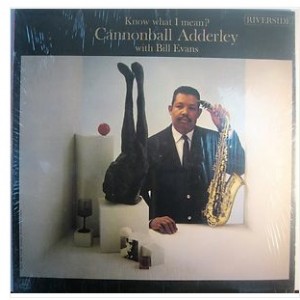Interesting Prices, Know What I Mean?
 I just jumped on eBay to check out a few jazz vinyl auctions before football starts here in the states, and this record was about to close: Cannonball Adderley with Bill Evans, Know What I Mean, Riverside 433. This was an original blue label pressing in M- condition for both the record and VG+ for the cover, still in its original shrink wrap. What struck me was the price tag: It was more than $230, which is really quite high for this record, based on historical prices. The auction just closed at $261. Regular readers will know that this is one of my personal favorites, certainly on my top 25 list of jazz records, and perhaps even in the top 10. But in the Jazz Collector Price Guide, we’ve never captured a copy at more than $100, let alone more than $250.
I just jumped on eBay to check out a few jazz vinyl auctions before football starts here in the states, and this record was about to close: Cannonball Adderley with Bill Evans, Know What I Mean, Riverside 433. This was an original blue label pressing in M- condition for both the record and VG+ for the cover, still in its original shrink wrap. What struck me was the price tag: It was more than $230, which is really quite high for this record, based on historical prices. The auction just closed at $261. Regular readers will know that this is one of my personal favorites, certainly on my top 25 list of jazz records, and perhaps even in the top 10. But in the Jazz Collector Price Guide, we’ve never captured a copy at more than $100, let alone more than $250.
Our friend CeeDee sent me a link to this record, when the price was in the low $100 range:
Walter Davis Jr., Davis Cup, Blue Note 4018. This is an original pressing in M- condition for both the record and the cover. It is a prominent one on my want list and anything less than $500 would be a sweet price, don’t you think? The price is now in the $300 range, but it hasn’t yet reached the seller’s reserve. We’ll see if it reaches the reserve when we look later.

reserve on Davis Cup was hit.
Interesting to see how TRUE jazz masterpieces (just like “know what i mean) are enventually recognized and accordingly priced to their artistic value. It is good news.
“Know What I Mean” is both my favorite Bill Evans and Cannonball albums(I know it’s a Cannonball date but I consider it like a co-bill). I prefer it to even “Kind of Blue”. Is that sacrilege?
That “Davis Cup” surely went for a nice price, wow! I think of that as around a $500 record or so.
I remember finding an old DownBeat and reading the original review of the Cannonball/Evans album. The reviewer gave it three out of five stars, calling it a routine date. History has judged otherwise.
“A routine date!” Wow. The only excuse we could give that reviewer would be that the music recorded in that era was routinely great!
it is bizarre that the rating in DB (the star system) had such an influence on the buying behaviour of people. Speaking of myself, I did not buy “Reunion” of Mulligan and Baker on Pacific Jazz at the time because it had only three stars. When it was out of print I only started to chase after it.
I remember the reason for the three stars: the album did not live up writer’s expectations in comparison to the original quartet performances.
When I had the record finally, the reviewer proved to be totally wrong.
Back in the Fifties, and perhaps beyond, certain Down Beat reviewers may have received too many review copies and listened to too many records they became blase. The same was certainly true in the 1930s and ’40s when reviewers dinged records that later became classics. With certain artists, I bought their records anyway regardless of the reviews.